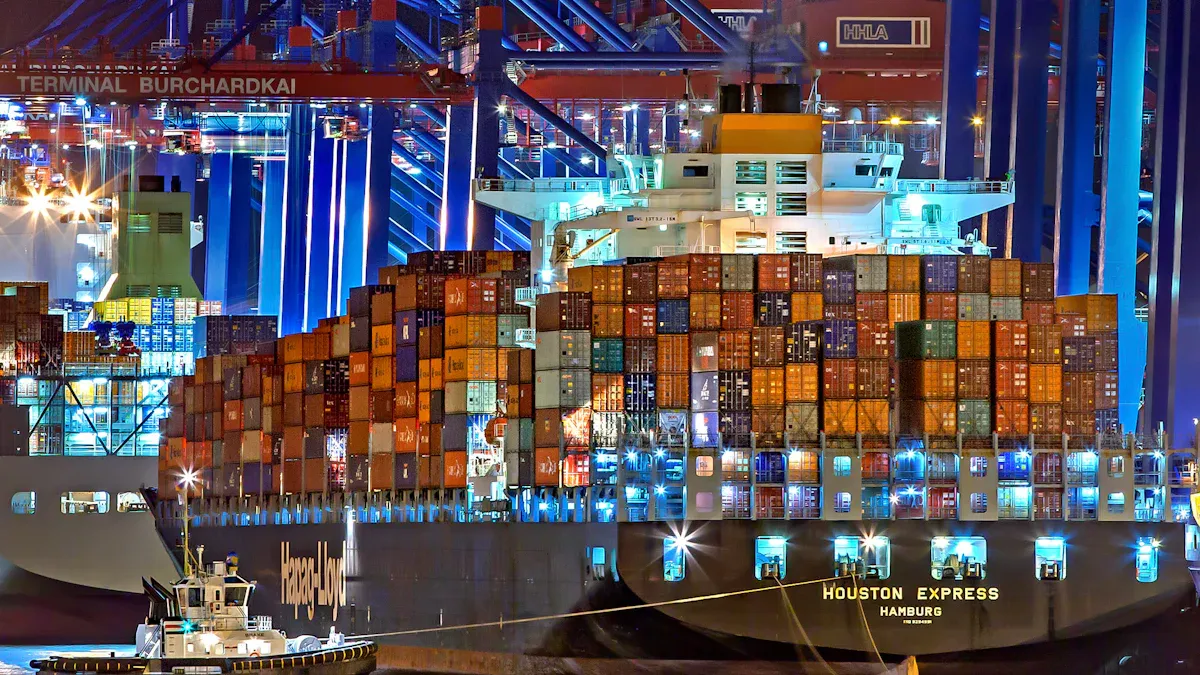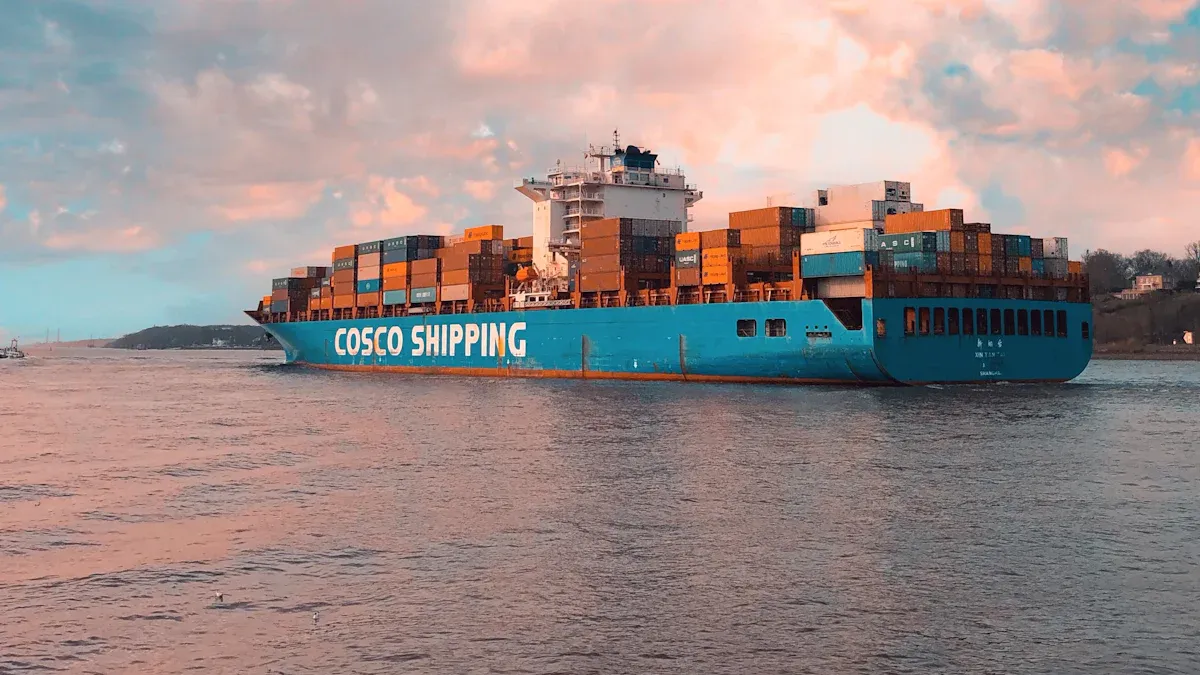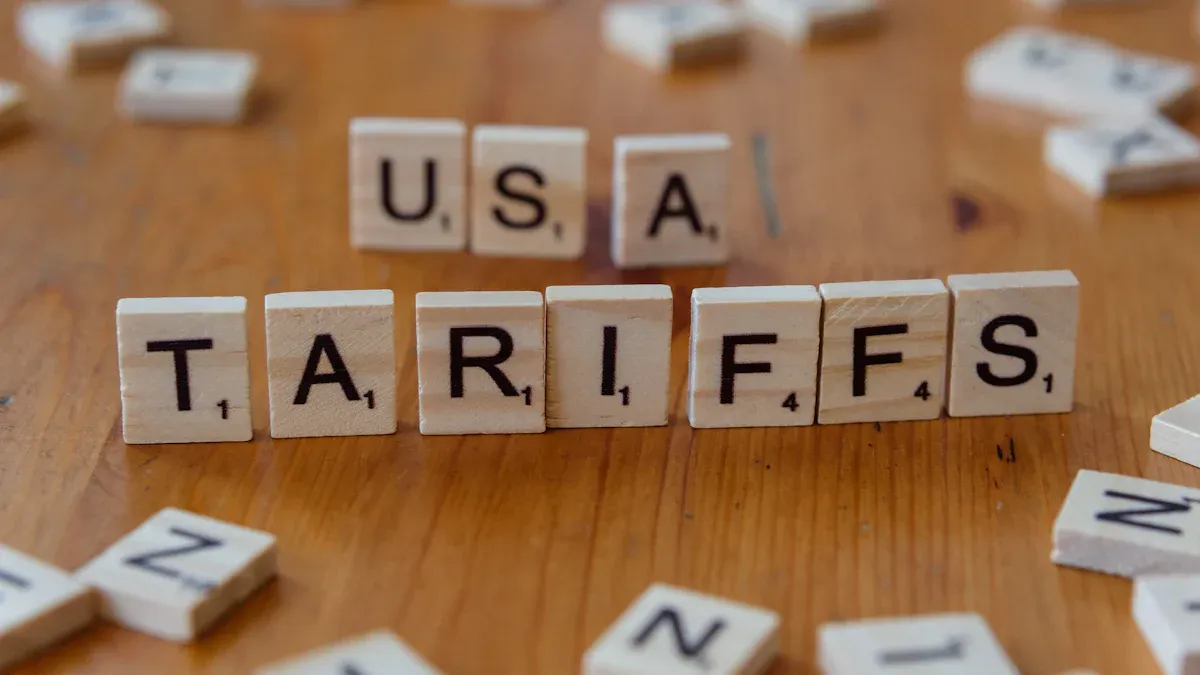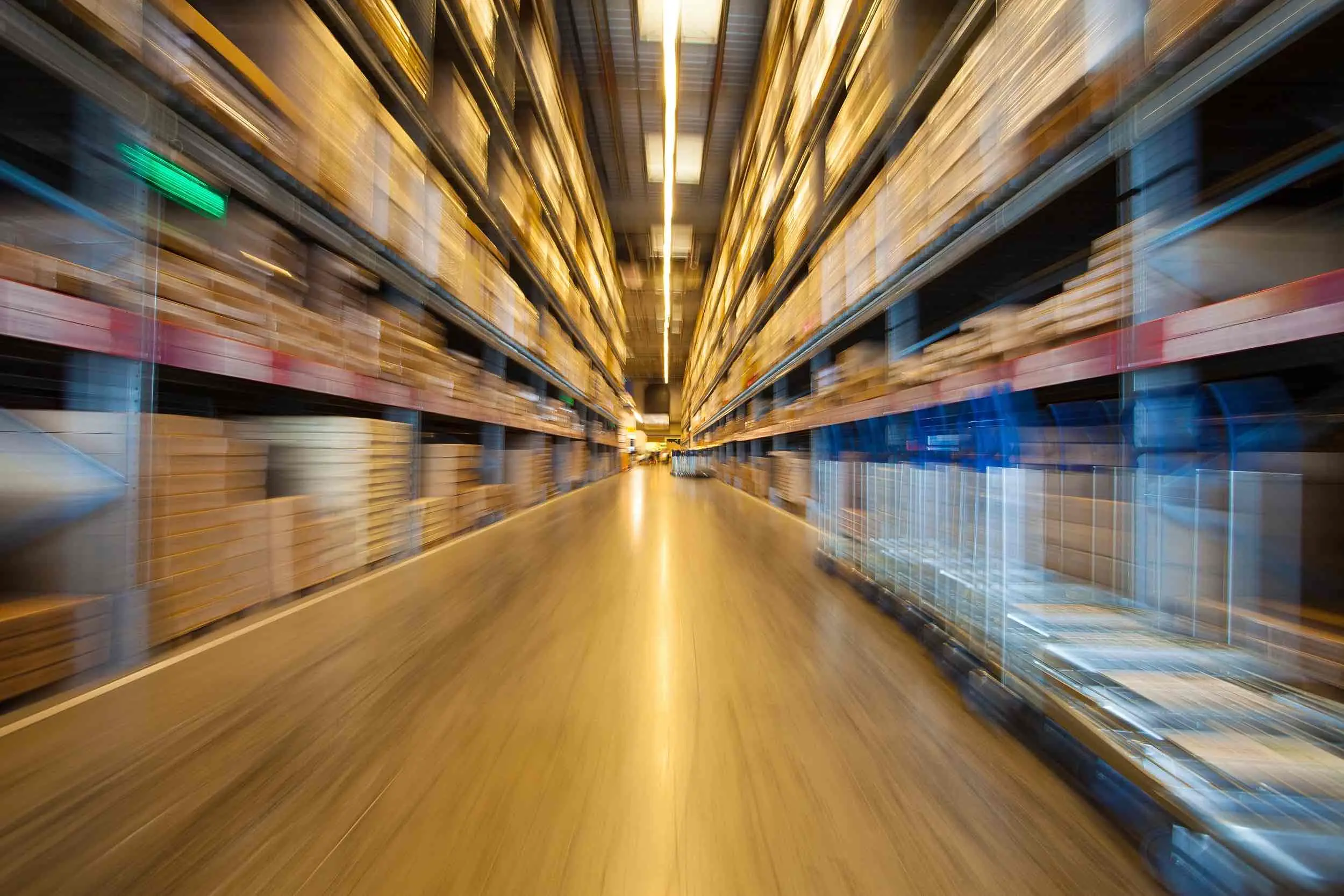How tariffs are related to trade

Tariffs related to international trade are crucial in shaping global commerce. They influence the pricing of goods and impact how countries collaborate in business. For instance, the U.S.–China trade war disrupted global supply chains and increased costs for companies. Historically, tariffs like the Smoot–Hawley Act reduced trade between nations and worsened economic conditions.
Key Takeaways
Tariffs are taxes on goods from other countries. They make foreign items cost more to protect local businesses.
Tariffs help local companies compete but can raise prices. They might also cause trade fights between countries.
Tools like JusTrade make customs easier. They help businesses handle tariffs and keep supply chains strong.
What are tariffs and their purpose in trade?
Definition and types of tariffs
Tariffs are taxes set by governments on goods traded internationally. They help shape trade rules and affect global business. Think of tariffs as tools to control goods crossing borders. The amount taxed depends on the type of tariff used.
There are two main kinds of tariffs:
Description | Measurable Criteria | |
|---|---|---|
Specific Duties | Fixed fees based on weight or quantity | e.g., $5 per kilogram |
Ad Valorem Duties | Percentage of the product’s value | e.g., 10% of the price |
Specific duties are simple, charging a set fee per item. Ad valorem duties depend on the product's value, making them flexible but harder to calculate. Both types help governments manage trade effectively.
The role of tariffs in protecting domestic industries
Tariffs protect local industries by raising the price of imports. This makes local products more affordable compared to foreign ones. During COVID-19, tariffs helped ensure critical goods like medical supplies were made locally.
Tariffs also fix unfair trade caused by subsidized exports. Some countries support their industries, creating unfair competition. Tariffs balance this, helping local businesses succeed. They can also promote fairness by taxing countries with poor labor practices, protecting workers' rights.
Tariffs raise import costs, helping local industries compete better.
They improve trade terms, benefiting local businesses over foreign ones.
But tariffs can also make goods more expensive for buyers. This shows how tariffs can be both helpful and challenging.
Revenue generation and trade regulation through tariffs
Tariffs bring in money for governments, funding public services and projects. For example, tariffs are expected to earn $1.5 trillion in the next decade. By 2024, they will have added $264 billion in customs duties, with $89 billion collected under Trump and $175 billion under Biden.
Tariffs also control what goods enter a country. Higher tariffs on certain items can reduce imports that harm local industries or the environment. This makes tariffs a useful tool for shaping trade policies.
In 2025, tariffs may add $171.6 billion to federal taxes, about 0.56% of GDP.
Proposed tariffs could raise $3.8 trillion from 2025 to 2034, though they might lower economic growth by 1.3%.
These numbers show how tariffs help raise money and control trade, making them key to economic policy.
How do tariffs work in global trade?

Impact on imports, exports, and trade balances
Tariffs are taxes that affect how goods move between countries. When a country adds tariffs to imports, foreign goods become pricier. This often makes people buy fewer imported items. Instead, they may choose cheaper, locally made products. This helps local businesses by giving them an advantage.
However, tariffs can also hurt exports. Other countries might respond with their own tariffs. This makes your country's goods cost more in their markets. As a result, fewer people may buy them, hurting businesses that sell overseas. Tariffs also change trade balances by controlling imports and exports. By reducing imports, tariffs can lower trade deficits but may harm global trade partnerships.
Tariffs raise import prices, helping local businesses compete.
They reduce demand for imports, boosting local product sales.
High tariffs can cause trade wars, inflation, and strained relations.
Tariffs as a tool for shaping trade policies
Governments use tariffs to meet economic goals. For example, they may add tariffs to protect new industries or stop unfair trade practices. Higher import prices encourage local production and create jobs. Tariffs also help in trade talks, giving countries bargaining power.
But tariffs can cause problems too. They may disrupt trade, scare investors, and affect global markets. For example, higher tariffs can lead to inflation. Businesses pass extra costs to buyers, raising prices. This increases living costs and slows economic growth.
Impact Type | Description |
|---|---|
GDP Impact | Tariffs may slow growth, even causing a recession. |
Inflation | Higher tariffs can raise prices, increasing inflation to 4.5%. |
Governments try to balance tariffs to protect their economies and keep good trade ties. Poor tariff decisions can cause economic trouble and harm international relationships.
The role of JusTrade in navigating tariff complexities
Understanding tariffs can be hard for businesses trading globally. JusTrade, a service by JUSDA, helps make this easier. It simplifies customs processes, ensuring goods cross borders smoothly despite tariff issues.
JusTrade uses smart tools like AI and big data to improve operations. It links teams like logistics, finance, and procurement, offering real-time updates on customs. This helps businesses handle tariffs better, avoid delays, and follow rules. Whether it's bonded zones or cross-border shipping, JusTrade provides custom solutions.
JusTrade handles over 1.4 million import/export declarations yearly, showing its expertise.
Its smart platform reduces errors and improves clarity, making tariffs easier to manage.
By using JusTrade's tools, businesses can improve supply chains and stay competitive. The platform not only simplifies customs but also helps you make smart choices, ensuring success in global trade.
Economic effects of tariffs on trade
Impact on GDP, inflation, and prices for consumers
Tariffs affect economies in several ways. They make imported goods cost more, raising prices for shoppers. For example, a 25% tariff on Canada and Mexico or a 10% tariff on China could increase inflation by 0.5 to 0.8 percentage points. If tariffs on China reach 60%, inflation might rise by 1.4 to 2.2 percentage points. These extra costs are often passed to buyers, making daily items pricier.
Tariffs also affect GDP. They can slow growth by disrupting trade and reducing business activity. For example, the 2018 tariffs slightly raised core inflation, which hurt spending and economic stability. While governments earn more from tariffs, the slower economy often cancels out these gains.
Effects on global trade and supply chains
Tariffs change global trade partnerships. Countries may respond with their own tariffs, causing strained relationships. For instance, higher tariffs on Chinese goods shifted U.S. imports to places like Mexico, Vietnam, and India. This reduces reliance on one country but disrupts supply chains.
Trade patterns also shift. A 23% drop in cross-border trade and a 7.2% fall in U.S. factory output show how tariffs harm industries. The logistics industry also struggles, with a 3.2% drop in worker demand due to changing trade routes.
How JUSDA helps with tariffs and supply chains
Dealing with tariffs can be tricky, but JUSDA makes it easier. Using tools like AI and blockchain, JUSDA improves supply chain efficiency. Its solutions help businesses handle tariffs better, cutting costs and staying competitive. For example, JUSDA’s platform uses real-time data to improve trade flows and follow customs rules.
JUSDA also builds stronger supply chains. By diversifying suppliers and improving operations, businesses can adjust to tariff changes. This approach reduces problems and helps companies succeed in a world shaped by tariffs.
Historical context: Lessons from tariffs in action

The Smoot-Hawley Tariff Act and its economic consequences
The Smoot-Hawley Tariff Act of 1930 shows how tariffs affect economies. This law raised taxes on over 20,000 imported goods to help U.S. industries during the Great Depression. But the results were not good. Other countries responded with their own tariffs, causing global trade to drop. From 1929 to 1933, U.S. imports fell from $4.4 billion to $1.5 billion. Exports also dropped from $5.4 billion to $2.1 billion. The U.S. GDP shrank from $103.1 billion to $55.6 billion during this time.
Global trade fell by 66%, hurting economies everywhere. This event shows that using too many tariffs can lead to trade fights and harm international business ties.
Modern examples: U.S.-China trade war and tariff policies
The U.S.-China trade war shows how tariffs work today. In 2018, the U.S. added tariffs on Chinese tech imports, costing U.S. companies over $32 billion. By 2024, tariffs on Chinese goods, like a 100% tax on electric cars, raised prices for buyers. These tariffs disrupted supply chains, making companies find new places to manufacture goods.
In 2025, the U.S. paused tariffs (except on China), boosting stock markets. This shows how tariffs can change economic confidence. But the trade war also showed how hard it is to balance protecting local industries with keeping global trade steady.
Insights for businesses navigating tariff challenges
Businesses need smart plans to handle tariffs. Getting materials from different regions can lower risks if one country faces trade issues. This makes businesses stronger against disruptions. Companies should also use technology to follow tariff rules and improve operations.
JUSDA’s tools, like JusTrade, help businesses deal with tariffs. JusTrade gives real-time updates and smooth customs processes. These tools cut delays, save money, and help businesses stay competitive in a world with tariffs.
Pros and cons of tariffs in trade
How tariffs help local industries and create jobs
Tariffs protect local businesses by making imports cost more. This helps local products compete better. It also creates jobs in industries shielded from foreign competition. For example, new industries, called "infant industries," get time to grow. Tariffs give them a chance to improve and compete globally.
Studies show tariffs can create jobs in protected areas. In 2019, tariffs caused $51 billion in losses for buyers and businesses using imports. But job growth in protected industries reduced the loss to $7.2 billion. This shows tariffs can help local economies despite some downsides.
Problems for shoppers and global relationships
Tariffs help industries but hurt shoppers. Higher import taxes make foreign goods pricier. Local companies may not lower their prices either. This means everyday items, like electronics or steel products, cost more.
Tariffs can also harm global relationships. Countries hit by tariffs may fight back with their own. This can lead to trade wars, disrupting supply chains. For example, during the U.S.-China trade war, businesses had to find new suppliers due to tariff issues.
Balancing tariffs and free trade
Balancing tariffs and free trade is important. Free trade lets countries focus on what they do best, boosting growth. But tariffs give short-term help to industries that need time to grow. Leaders must weigh these benefits against higher prices and wasted resources.
Economic studies show tariffs protect local industries but hurt efficiency. These studies have limits because of different data and assumptions. Businesses should plan for both tariffs and free trade deals. This helps them stay strong in a changing global market.

JUSDA Solutions
To provide you with professional solutions and quotations.
Tariffs are important for global trade. They change how economies work. Tariffs affect jobs, business activity, and how goods are made. They help local industries but can cause problems. Supply chains may break, and work may slow down. JUSDA and JusTrade make dealing with tariffs easier. Their smart tools help businesses follow rules and keep things running smoothly.
See Also
Exploring How Global Trade Policies Shape Economic Landscapes
Understanding The Importance of Supply Chains in Global Trade
Achieving Success in International Trade Through JUSDA Solutions
